How to Build an MVP: Steps, Tips, and Costs
 6 February 2023
6 February 2023Untested and unvalidated ideas are perilous. Many startups with seemingly great potential have gone on to build products, raise funds, and garner attention only to go bust. Well, because the idea seemed good on paper. But users failed to pick up the product and use it.
The biggest challenge startups must address is how to validate their idea with their target users, while doing so in the shortest time and in the cheapest way. That’s where the concept of creating an MVP comes in.
MVP is the minimal viable product. If it’s an application, it contains the minimum core features required to solve a user’s needs. For instance, Uber’s MVP, launched in 2010, contained a highly simplified interface featuring one car driven by the founder, Travis Kalanick. Users only had the ability to hail a cab. Features such as the estimated wait time were added later.
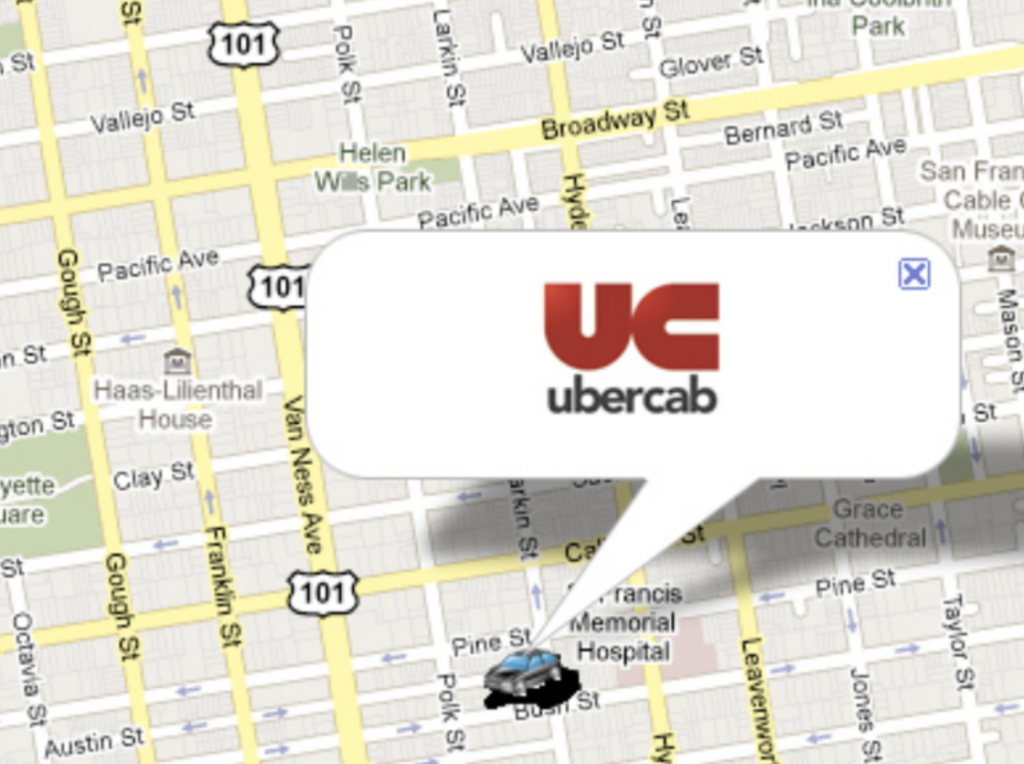
In this article, we will explore how to build a minimal viable product. You’ll learn about the origins of the concept, its benefits, and awesome MVP examples from successful companies.
Purpose of an MVP
Since the dawn of the digital revolution, a number of startup founders have dabbled with the idea of creating an MVP without really putting the concept into concrete terms.
In the 1990s, Nick Swinmurn could not find a particular pair of sneakers at his local mall. During his search, he discovered that there were no major online shoe retailers. Seeing an opportunity, he did not embark on building a full-fledged website, renting space, or securing supply lines. Instead, Nick attempted to find out if people would buy shoes online by building a simple website and populating it with pictures of shoes from local stores. If someone made a purchase, he would go and buy the shoes in person.
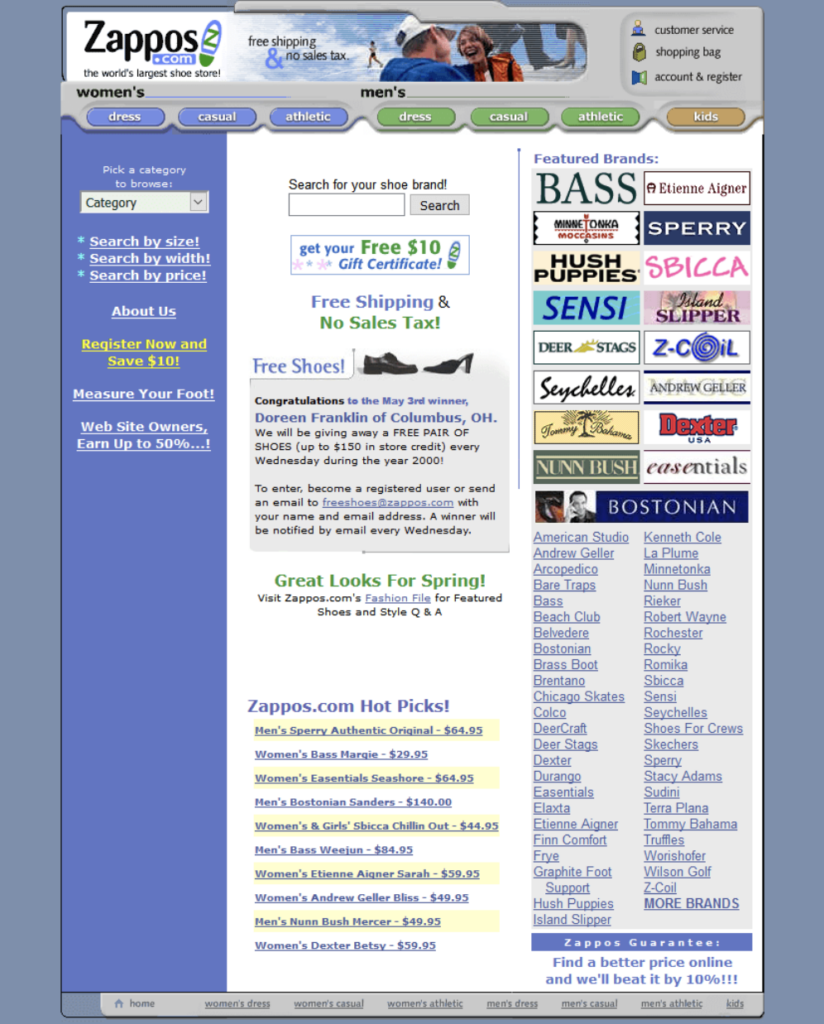
Zappos went on to become a major shoe retailer, and Nick’s approach was cited as one of the minimum viable product examples in The Lean Startup book first published in 2011 by author Eric Ries.
According to the book, the meaning of an MVP product is a redacted version of a new product that allows a startup team to collect the maximum amount of validated learning about customers using the least effort.
Validated learning is the process of obtaining real data about how your target customers value your application or interact with it. Ries saw the importance of validated learning firsthand as part of a startup team building IMVU, a social network in 2004.
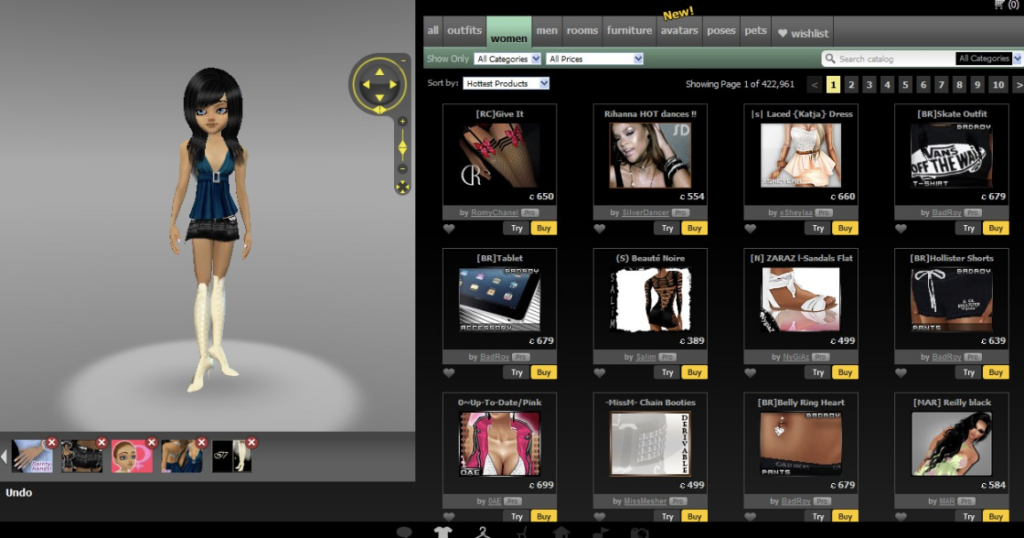
IMVU was an instant messaging and social entertainment website where users could build 3D avatars and use them to connect to their friends, play games, or meet new people. But at the time, top internet messaging apps claimed the largest share of users.
Ries and his team figured that it would be difficult for people to switch from the top IM networks. So rather than building their own messaging capabilities, they decided to integrate all the popular IM networks into their app.
After spending about six months building the app and integrating the IM networks, IMVU launched but no one joined. Oblivious to what could be wrong, they invited potential users to interact with the application. It was then that they discovered that people were open to using a new internet messaging network if it was much cooler.
All their efforts spent integrating popular IM networks essentially went down the drain. In hindsight, Eric discovered that the best approach was integrating one network and launching the app to collect validated learning from users. It would have allowed them to fail fast and cheaply.
The most fundamental purpose of MVP development is to quickly bring your idea into the market in a limited time and with a limited budget. This allows you to test if it solves user problems. Testing should involve the target audience to obtain feedback for analysis and improvement.
MVP advantages
What are the upsides of building an MVP for startups?
1. Idea evaluation/Hypothesis testing
The MVP offers the best tool for experimentation and idea evaluation, as it encourages startups to deliver a usable product in as little time as possible. They can measure results from user interactions with the actual product and assess if people are interested or if it sufficiently solves their problems. Once the hypothesis is validated, the startup can pursue full development or add other necessary features.
“We must learn what customers really want, not what they say they want or what we think they should want.”
Eric Ries
2. Quick launch
The Lean Startup ideology advocates for fast cycle times. Teams need to take the shortest time to complete the Build-Measure-Learn cycle.
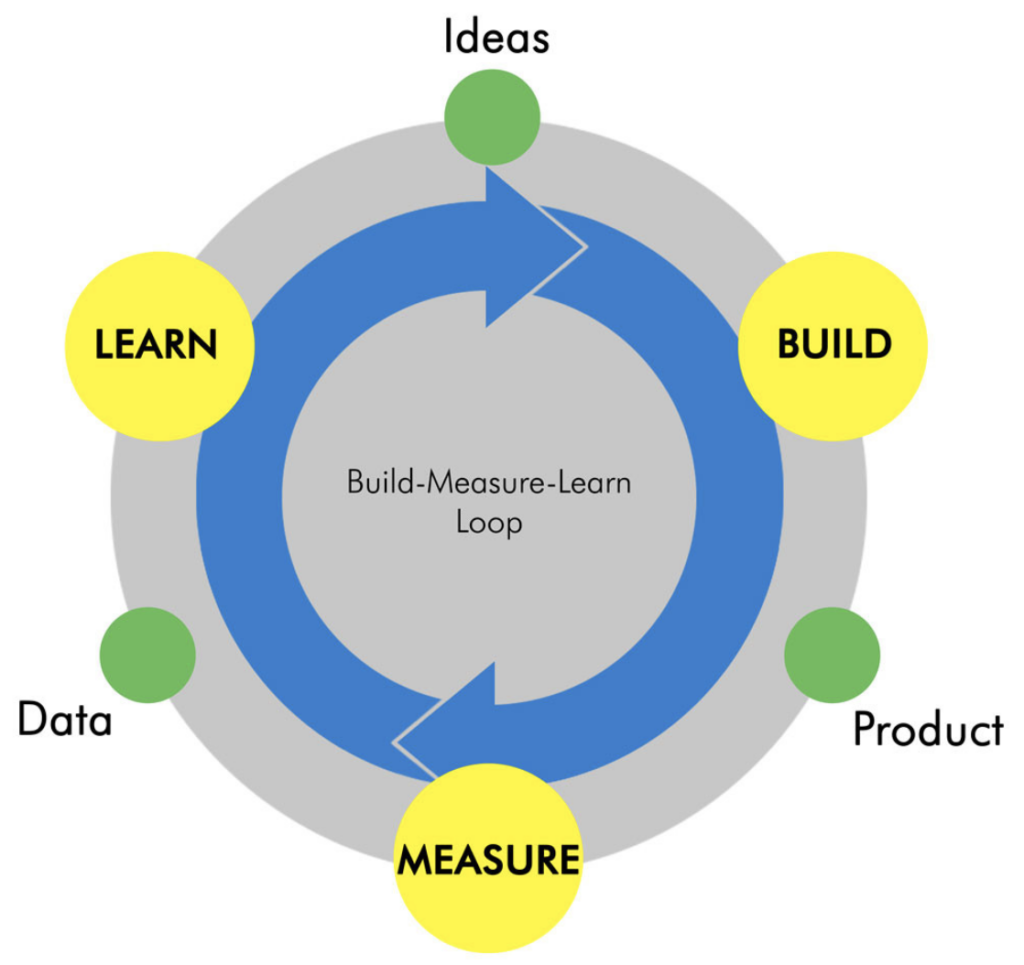
With an MVP, they can focus on the minimum features, taking less time in the Build stage. Quickly launching the product can even provide the first-mover advantage, making it easier to establish strong brand recognition and product royalty before the market becomes saturated.
Many brands still benefit from first movers’ advantage including Facebook (social media), Uber (cab hailing), and Amazon (e-Commerce).
3. Focus on core values
Founders and teams can easily become distracted during the app development for the startup, taking a completely different trajectory than what was intended. They can become bogged down trying to implement features found in competing apps to remain competitive.
MVP development helps alleviate confusion and increases focus, as teams must identify the core features. Documenting the tasks and milestones in the project scope further elevates confusion and unexpected changes that may result in project delays.
4. Get quick feedback from users
Validated learning, involving target users, is the only definite way to know if an app is useful. With an MVP, you can obtain this feedback fast as the app will be developed and launched in the shortest time possible. User feedback can help identify how to improve the app to solve the user’s problem more precisely.
“It’s really hard to design products by focus groups. A lot of times, people don’t know what they want until you show it to them.”
Steve Jobs
5. Financial risk reduction
Building an MVP quickly and with minimum features is cheaper than spending development time creating a perfect product that is not validated.
It promotes optimum budget spending, providing an extra cushion if the idea is not validated or requires extra work. In fact, many successful companies pivoted from their initial idea. Twitter started as a way to utilize SMS messages to communicate with a small group of people. Instagram focused on check-in features before the founders realized that it was too similar to Foursquare.
A time may come when it’s necessary to abandon the initial idea, and it will be less risky if your team spent minimum resources testing it out. If your budget allows it, building a simple MVP gives your team the opportunity to test multiple ideas at once.
6. Investors’ attraction
An MVP that demonstrates real demand for the product is an incredibly powerful tool for attracting investors’ attention and obtaining funding.
In Uber-Cab’s first pitch to investors, they stated that after two weeks on the App Store, the first set of 10 drivers was already handling more than 10 rides on weekend evenings in San Francisco. UberCab mentioned that 50% of people that signed up requested a ride.

How to Build a Minimum Viable Product?
Learning how to develop a minimum viable product is not that complicated. Here are the steps you can take:
1. Define the problem
The singular purpose of building an app or launching a product is to solve the user’s problem by providing useful features.
Before getting to the problem-solving part, you should define the problem your target users are experiencing. It’s ideal to express it as a problem statement, where you frame the need or issue in a way that’s actionable for the development and design team.
You can come up with a problem statement with the following recommendations:
- Provide the background and setting by describing how things should work in an ideal world;
- List the desired state or goals you want to achieve;
- Include facts about the problem;
- Show the benefits of your solution;
- Explain who is affected by the issue, specifying information about their personas, demographics, and psychographics;
- Frame the problem from the user’s perspective using their own words and experiences;
- Demonstrate why the solution will work.
The problem statement may be as short as a few sentences or several paragraphs long. Ideally, try to express the problem in as
few words as possible but with sufficient details to frame the solution clearly.
2. Conduct Market Research
The purpose of conducting market research as you create an MVP is to gather information about the target consumers’ needs and preferences.
Market research entails data collection and analysis. You can use various methods, including surveys, focus groups, social media listening, observations, qualitative interviews, field trials, and more.
In the beginning, narrow your focus to a small user base, not all possible users the solution can help.
Competitor research is a critical component of market research. All startups inherently have direct and indirect competitors. Review the market for similar applications, websites, or products. Analyze features offered by competitors for some insight into what users find valuable.
As you figure out how to create a minimum viable product, analyze for any weak areas or needs competitors have overlooked. Going through negative reviews may be a good starting point.
*You don’t need to spend weeks creating an official business plan. Explore your business model using the business model canvas.
3. Define the main features and prioritize them
A key step in the MVP process is figuring out the main features of the app. To get there, define the user flow showing the shortest
path users can take to complete a task.
The user flow should help achieve the primary goal or address the main pain point. For instance, in a telehealth app, the biggest pain point is getting seen by a doctor. The basic user flow may entail: Creating an account, finding doctors, scheduling an appointment, and holding a live call session.
When figuring out how to build a minimum viable product, the core features should then correspond to the user flow.
Here are some additional hacks that can help with feature selection:
- Time box your features: Identify how long it takes to develop each feature, and choose features that conform to your timeline. For instance, if you’re planning to launch in 1 month, don’t include features that cumulatively take 3 months to create.
- Document and finalize the features and user flow: It’s quite tempting to add and remove features during the build process. But if they are in writing, it’s easier to know when you’re deviating from the plan, hence promoting accountability.
- Reduce your features in half: Speed is the biggest priority for an MVP. After listing all the must-have features, review if too many features have been added. There is always room to simplify the spec to speed up the development.
4. Design and develop your MVP
At this stage, you need a development partner for design and development if you don’t know how to build an MVP yourself. There are various development options to choose:
- Freelancers
- In-house team
- Outsourcing agencies
The ideal service should be affordable, dependable, and capable of quickly developing the application for launch. There is little wiggle room for mistakes or delays. That’s why hiring an in-house team can add too much time and cost more. With freelancers, there may be issues with availability or ability to deliver.
Hiring an MVP development company is a safer bet, but you may have cost concerns. Actually, hiring development agencies in some regions such as Eastern Europe can be cheaper than even hiring freelancers in places such as the US. We have prepared a guide on how to find developers for startups.
Our agency, Attract Group, provides all the expertise in one place. Your team may include project managers, business analysts, DevOps, and more. If you’re new to outsourcing, we also have a guide on how to outsource website development.
5. Launch MVP
The most impactful MVPs were launched quietly. Still, it’s essential to prepare for a successful app launch and build traction with the initial set of users.
Prior to launch, set some goals, for instance, the desired number of active installations by a certain date. Prepare a marketing plan that details strategies to promote the application to the right audience: running social media ads, creating a simple website, distributing flyers, etc.
Additionally, the MVP should ship with mobile app analytics tools for measuring various metrics.
Launching an MVP may be a bit unsettling. The app may look simplistic and unfinished. But this should not bother you too much. Aim to deliver a working product that performs its core task effectively without bugs or security issues.
6. Get feedback, learn, and iterate
After launching the MVP, you’ll enter the most exciting phase of the MVP development process: Measuring and Learning.
Try to obtain candid feedback from target users identified during the market research. Request reviews with feedback forms or even follow up with users in person.
There will be a lot to learn as you’re not starting out with a perfect solution. But it’s essential to determine that there is a real demand for the application and that people are using it, not simply downloading it.
The insights garnered may be utilized to improve the app’s features before releasing it again.
What to do after creating an MVP
Creating an MVP is the first step. Many other steps will come after, including collecting feedback on how users interact with the application. The feedback should be analyzed and improvements made until the KPIs are realized.
Examples of key KPIs to track include:
- User engagement metrics – They showcase how users interact with the app. Top metrics include Retention Rate, Daily Active Users, Average Session Length, Churn Rate, Exit Rate, etc.
- Acquisition metrics – The metrics track the cost of downloads, marketing, and generating revenues. Examples include Customer Lifetime Value, Cost Per Install, and Average Revenue Per User.
- Conversion metrics – They determine if users are completing desired goals. Examples include Goal Completion, Average Order Values, and Time to Goal Completion.
It may become confusing as to which metrics to track or improve. Just identify the main growth drivers that present a strategic opportunity to accelerate growth. For instance, the number of new downloads may be a growth driver.
Aim to improve each growth driver until it reaches the expected baseline, rather than implementing many improvements at once.
If the goal is to receive investments, the application should be improved until it’s ready for scaling and presentation. The growth driver here may entail finding active users and building traction.
How much does it cost to develop an MVP?
The cost to build an MVP will generally depend on many factors. Some of the key determinants include
- Functional complexity – This is determined by the number of features and how complex the features are to implement. For instance, it’s more complex to create an application with live video chat features compared to text messaging only.
- Platform – The target platforms can influence the costs to build an MVP. For example, it’s costly to develop separate native applications targeting iOS and Android platforms as it requires separate teams. But it’s cheaper to use a cross-platform development language such as Flutter to develop one codebase that can be reused up to 90% between platforms.
- Design complexity – This is influenced by the number of screens the application will have and the need to build custom components instead of utilizing reusable components.
- Number of specialists involved in the work – The team composition will influence the total man hours consumed for the project. Everyone has a part to play and having all the help can result in a better product. Still, there are ways to save such as assuming certain duties that a project manager or business analyst would fulfill.
- Company rates – The hourly rate multiplied by the total work hours will result in the final cost. But choosing a lower hourly rate doesn’t always mean spending less.
Wondering how much your MVP will cost to build? We can provide estimates of the cost of MVP versions of different applications (from our bot). Speak to our team.
Outsourcing the development work to agencies in particular regions can translate to savings. Here are different IT sourcing rates to expect based on the company’s location:
| Region | Rates | Top 5 Development Centers |
| Africa | $20 – $40 | South Africa, Egypt, Ghana, Nigeria, Mauritius |
| Asia | $18 – $45 | Singapore, India, Philippines, Vietnam, Thailand |
| Eastern Europe | $25 – $70 | Ukraine, Romania, Poland, Bulgaria, Hungary |
| Latin America | $30 – $70 | Chile, Brazil, Mexico, Argentina, Peru |
Ultimately, the mobile app MVP cost will depend on the hourly rate multiplied by the number of hours spent during the development.
How long will it take to build an MVP? A simple MVP mobile application may require 300 to 600 hours. Still, it may take longer depending on the project scope. In some niches, the MVP may require more than 1000 hours of mobile app development time.
Mistakes when building an MVP
Creating an MVP is still an intricate process, even with the simplicity of the final outcome. Actually, it can be argued that it’s much easier to do complex things than to achieve simplicity. That’s why there are some common mistakes that may plague the project and may be repeated by founders, CEOs, executives, and the development teams. Watch out for them and try to outpace them:
- Overlooking the need for quality feedback
Gathering quality feedback is an easy thing to overlook. Founders may choose to trust their personal intuition on what users want. It’s even more probable if the founder faces the problems they are trying to solve. Interacting and talking with real users is highly important and can’t be replaced even with the most robust secondary research data.
- No clear goals
The absence of clear goals and direction is one of the most common problems that will impact MVP development. It may stem from various causes. The founder may lack a concrete image of the product they wish to bring to market. It may be born out of failing to understand the needs or problems of a particular niche or market segment. The issue may be simply caused by failing to communicate effectively.
- Striving for excellence
Striving to build a perfect product may cause significant delays in the development process, opening opportunities for competitors to launch their products first. The app may end up costing a lot of money only for the team to realize that they would have taken a completely different direction.
- Unprofessional development team
Hiring the wrong app development company without sufficient experience can result in mistakes and project delays. The right team should have some requisite experience in the niche with a proven portfolio of products.
- Wrong Technology
Choosing the wrong technology to build the MVP can lead to budget overruns. For instance, opting to develop separate apps for Android and iOS can end up costing a lot of money. And the application may have a similar level of performance if it was built with a cross-platform development framework such as Flutter. The development team should also select the right tech stack.
Examples of MVPs
Let’s look at several MVP examples showing how some top companies started out.
Airbnb
Airbnb is one of the quintessential minimum viable product examples. In 2007, two of the founders, Brian Chesky and Joe Gebbia were roommates at a San Francisco property and struggled to make their rent.
Exploring ways to raise their rent money, Joe Gebbia emailed Brian about a way to make extra bucks by turning their place into a “designer’s bed and breakfast” to host the young designers that would flock to the city for a 4-day event. He planned to provide guests with wireless internet, a small desk space, a sleeping mat, and breakfast.
Instead of sleeping mats, they settled for three airbeds they could fit into their living room. Thus the idea of Airbed & Breakfast was born.
Listing their property on Craigslist seemed too impersonal, so they built their first website solely to promote their apartment, and managed to host three guests for $80 per night, providing them with breakfast every morning.
Their MVP was a simple website that was not automated in any way. They saw the potential of providing accommodation targeting tech conferences.

Etsy
The idea for Etsy came around when the founders, Rob Kalin, Jared Tarbell, and Chris Maguire, were developing an internet forum for a crafting community, Crafters.org.
Members of the community were complaining about the high fees for selling items on eBay. Many other startups had tried to replicate eBay’s success unsuccessfully as they would often run out of funds before achieving market fit or realizing that there was no demand for their platform.
Etsy took a different route creating a simple MVP focusing on the core feature: giving users the ability to sign up and list products for sale.
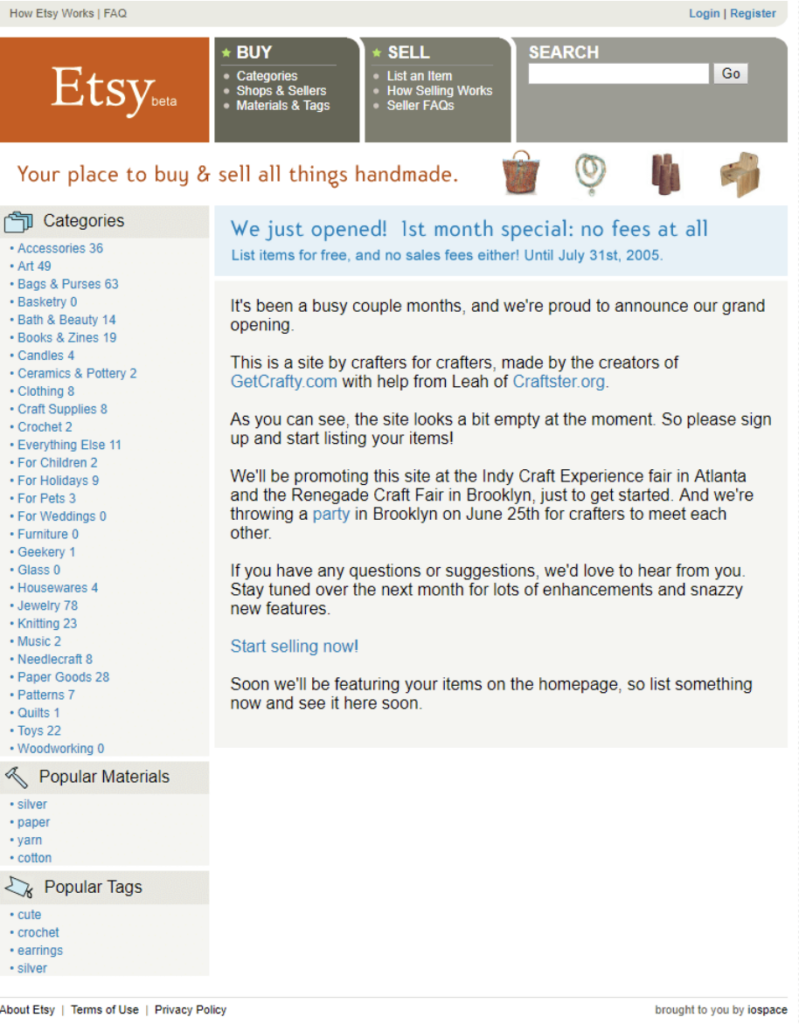
You can see how they attempted to build traction for the website by promoting it at an Indie Craft Experience fair in Atlanta and throwing a party for crafters to socialize.
How Attract Group can help you with MVP development
To summarize:
- Building an MVP is the best way to obtain validated learning;
- Startups should spend the shortest time building the MVP;
- Speed is more important than cost;
- It’s better to spend the least amount of money as it makes it possible to try ideas or change course if the idea doesn’t work out;
- You should cycle through the Build, Measure, and Learn feedback loop.
Attractgroup has successfully brought many app ideas to the market with quality MVPs. For instance, recently, we helped build Flustr – A social network with live streams, and Forum, a mobile app MVP example for a property management solution.
For each MVP project example, the goal was to include core features in the MVP that would allow the founders to test the viability of their idea. For instance, with Flustr, the focus entailed posting a challenge, selecting opponents, choosing music, and battling live.
If you’re thinking of developing an app in any niche, talk to our team for guidance on how much it may cost and the must-have features. Get a free quote here.










